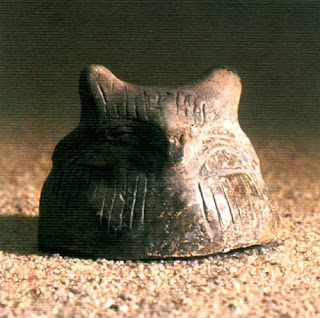National Museum of Serbia has this to say about these artifacts:
"Prosopomorphic lids are common in the entire territory of the Vinča culture and are all very similar. Most are of cylindrical shape and have prominent horn-like lugs, a molded nose, conspicuously marked eyes and varied decoration. This type of vessels represents a specific form of Vinča ware and had a double function. It was used as a cover for amphorae with a cylindrical neck. Its other and much more important function was to protect the contents of the vessel from evil spells and unknown powers. The most expressive details on the face are the eyes, which attract particular attention. They are associated with the so-called "mystical eyes", to which special significance was attached. It is a widespread belief that the eyes are "the mirror of the human soul", and that they can also be wicked and capable of casting evil spells. They often have the power to avert negative magic power from the individual or the community, so that they assume an apotropaic function. In addition, the eyes possess the power of constant observation, wakefulness, control, surveillance of the behavior of people, and in this way they have an influence on their magic beliefs and religion. Finally, prosopomorphic lids may represent a mask which has the magic power to protect the ordinary human being or the priest-wizard from the unbounded energy of the deity before which he appears. As such, they cannot be considered in isolation from the other Vinča sculptures, altars and cult objects, for they are all associated with the religious rituals and beliefs of prehistoric communities."
Basically no one knows what these things are and what they represent. This is how they were used:
This next picture is a picture of the Eurasian eagle-owl...
Do you see any similarity?
Owls are one of the oldest species of vertebrate animal in existence, fossils have been found dating back 60 million years, showing the bird to have changed very little in that time.
Throughout the history of mankind, the owl has featured significantly in mythology & folklore. They are one of the few birds that have been found in prehistoric cave paintings. This is an engraving of an owl from the the Chauvet-Pont-d'Arc Cave in southern France. The cave has the earliest known and best preserved figurative cave paintings. The dates of the paintings have been a matter of dispute but a study published in 2012 supports placing the art in the Aurignacian period, approximately 32,000–30,000 BP.
The Owl has been engraved by using a tool on the soft surface of the rock, once this surface had been prepared and scraped clean.
The intriguing aspect of the Owl is that it is depicted with its head seen from the front but its body from the back. It may well be the earliest representation of the birds unique ability to turn its head through 180 degrees, an ability which many cultures associate with supernatural powers.
Owls have been both revered & feared throughout many civilizations from ancient to more recent times. It is probably their ability to see in the darkness that inspired people to associate owls with both prophetic wisdom and particularly the visions of doom and death. In most parts of the world the owl cry heard in or near a home usually meant impending death, sickness, or other misfortune. They are also widely believed to represent the souls of people who have died or that they carry the souls of people to the underworld.
So, what do you think? Are the above lids representations of owl heads? And if so, what did these lids cover? What did Vinčans associate owls with?









owl from my city ;-)
ReplyDeletehttp://galeriabielska.pl/?d=details&sek=dodatkowe_artykuly&idArt=1917
Possibly the lids of containers used by those who hunted with trained Eagle Owls?
ReplyDeleteBirds feature prominently in Vinca culture symbolism. The eagle owl, the bird which ruled the night in the same way the eagle ruled the day must have had special place in their belief system. These types of tops were hardly everyday's objects...But that is one possibility. Thank you for your comment.
DeleteThis comment has been removed by the author.
ReplyDeleteActually, I dont think they look like owls at all. Unlike the both photo and the Chauvet-Pont de Arc cave engraving, the "ears" are not directly above the eyes, but on the sides of the head, as in a cat. I would say the heads are just decorative "lids" for a certain type of amphora. Probably, the shape of the particular vessel resembled some sort of animal when the head shaped "lid" was on. Maybe there was a good lick charm aspeect, or maybe it was just funny, Why does every piece of art or craft have to be spiritual?
ReplyDeleteMatty, thank you for your comment. Look how the head finishes just below the protruding bit. There is no mouth, which would be seen if this was a cat. There are much older plastic depictions of cat heads which feature the characteristic "cat mouth" design. This looks much more like a "beak" rather than the nose, as the beak is the end of face on birds. Have a look again at the picture of the eagle owl.
DeleteThese were lids, but the lids of what type of containers? I doubt that these were just decorative pieces. Even good luck charm is part of spiritual system...
I agree theyre not cats, But they do have mammalian-like ears. I guess they could be stylsed riffs on some kind of owl legend or tradition, so Ill bow to your superior knowledage on the lids.
ReplyDeleteFascinating piece about owls
Cheers
My first thought was that those lids resembled cats, not owls. They certainly are stylized in the way ancient art tends to be
ReplyDelete